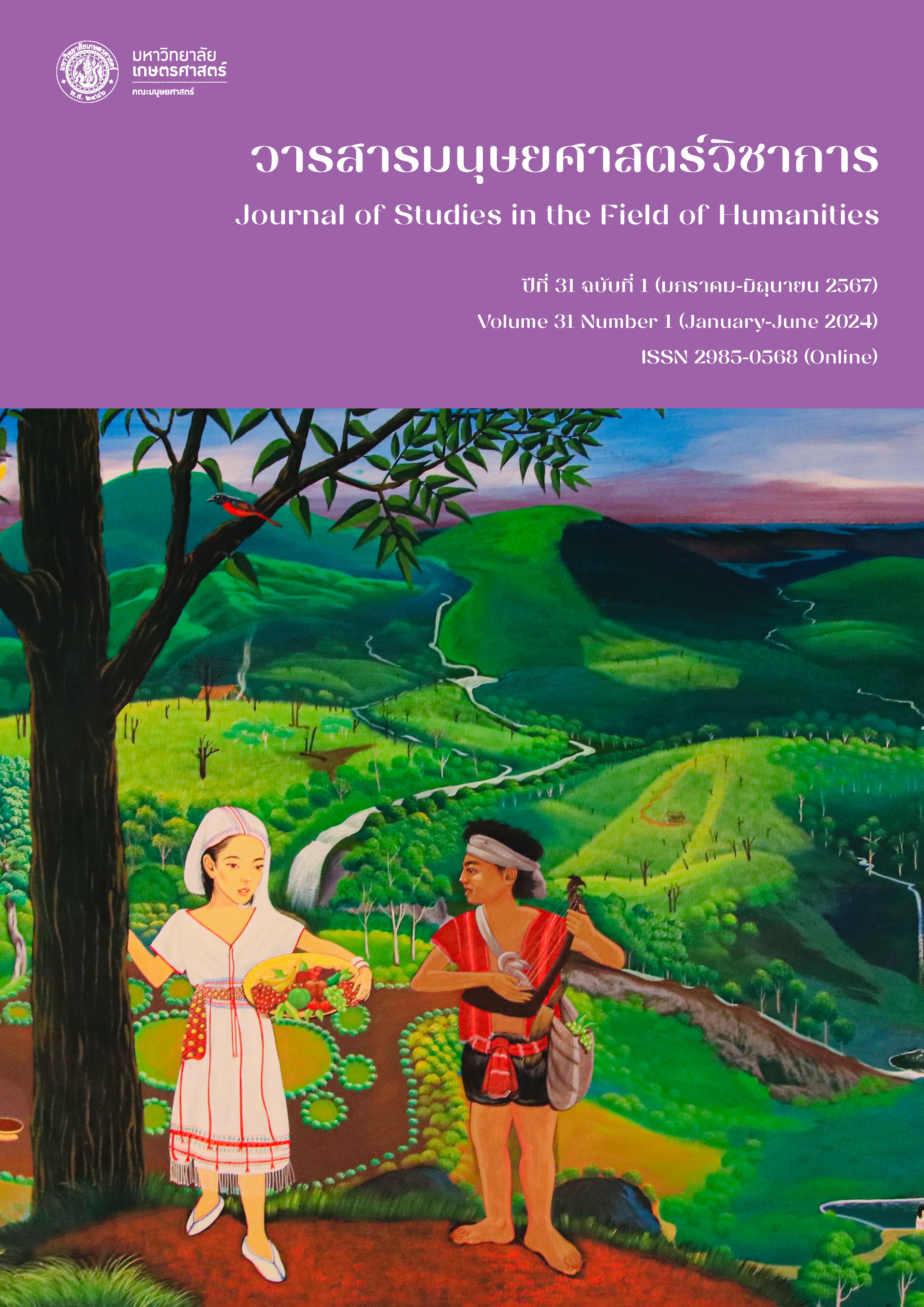The Creation of Tai Yuan Folk Performing Art, Sao-Hai District, Saraburi Province in Covid-19 Situation
Main Article Content
Abstract
The creation of Tai Yuan folk performing art in the Covid-19 situation purposed to contemporize the Tai Yuan folk art in the performance “Tee Sud Tai.” The scope of this study is at Tai Yuan Village, Sao-Hai District in Saraburi Province. This is a qualitative and creative research studying from documentation, interviews with related persons, field study survey, and experience of the researcher.
Based on the research, the author found that the application of the contemporary Tai Yuan folk art performance “Tee Sud Tai” included local weaving lifestyles, dance conservation, costume dressing, and hairstyle to create and demonstrate a new local performance that indicates Tai Yuan identity during the Covid-19 situation. It could be the tool to allow audiences to understand and see new aspects from this creative work. Additionally, the work is different from the original one. The author has no desire to destroy the original performance but intends to maintain knowledge and local wisdom in the new world when the situation is changing all the time.
Article Details

This work is licensed under a Creative Commons Attribution-NonCommercial-NoDerivatives 4.0 International License.
References
กรมควบคุมโรค. (2563). 9 วิธี หนีโควิด. สระบุรี: กรมควบคุมโรค จังหวัดสระบุรี.
ชุติมา มณีวัฒนา. (2550). เอกสารคำสอน รายวิชาการกำกับการแสดง 1. กรุงเทพฯ: คณะศิลปกรรมศาสตร์ มหาวิทยาลัยราชภัฏสวนสุนันทา.
ณฐภรณ์ รัตนชัยวงศ์. (2564). ละครเวทีในกรอบ: ความท้าทายและการปรับตัวของนักแสดงกับการนําเสนอละครเวทีออนไลน์ในยุคโควิด-19. วารสารศิลปวัฒนธรรมสวนสุนันทา, 1(1), 1-22.
ประชาชาติธุรกิจ. (2563). คนกรุงเทพฯ แห่กลับภูมิลำเนา หมอชิตแน่น (ภาพชุด). สืบค้นจาก https://www.prachachat.net/general/news-435775.
ภัททิรา วิริยะสกุลธรณ์. (2551). บทบาทสื่อพิธีกรรมในการอนุรักษ์แม่น้ำป่าสักของชาวไท-ยวน อำเภอเสาไห้ จังหวัดสระบุรี (วิทยานิพนธ์มหาบัณฑิต). จุฬาลงกรณ์มหาวิทยาลัย, กรุงเทพฯ.
ภูกิจ พาสุนันท์. (2563). “รำชาตรี หนีโควิด” โดยวิทยาลัยนาฏศิลปลพบุรี สถาบันบัณฑิตพัฒนศิลป์ กระทรวงวัฒนธรรม. สืบค้นจาก https://web.facebook.com/phukit.pasunant/posts/3101662436540026.
ยูเนสโก กรุงเทพฯ. (2563). วิกฤตการณ์โควิด-19: แรงผลักดันสู่การเรียกร้องในการปฏิรูปนโยบายอุตสาหกรรมงานสร้างสรรค์. สืบค้นจาก https://bangkok.unesco.org/th/content/Covid-19-crisis-drives-call-creative-industries-policy-reform.
วนศักดิ์ ผดุงเศรษฐกิจ. (2559). การสร้างสรรค์ละครล้านนาร่วมสมัยที่พัฒนาจากเพลงพื้นบ้านภาคเหนือ: กรณีศึกษาเรื่องศศิวิภา ริชาร์ดสัน. วารสารวิจัยและพัฒนา มหาวิทยาลัยราชภัฏสวนสุนันทา, 8(3), 9-23.
วนศักดิ์ ผดุงเศรษฐกิจ. (2561). “ไล่ล่า” การสร้างสรรค์การแสดงโนราร่วมสมัยตามแนวคิดกลวิธีการแสดงของสตานิสลาฟสกี. วารสารอักษรศาสตร์, 46(2), 105-170.
วิภา จิรภาไพศาล. (2561). อัตลักษณ์คนไทยวน เรื่องเล่าจากย่ามและผ้าซิ่น ฯลฯ. สืบค้นจาก https://www.silpa-mag.com/news/article_19466.
สำนักงานสถิติแห่งชาติ กระทรวงดิจิทัลเพื่อเศรษฐกิจและสังคม. (2562). สรุปผลการสำรวจภาวะการทำงานของประชากร. สืบค้นจาก shorturl.at/dhOV6.
หยกฟ้า อิศรานนท์. (2563). อาการรังเกียจโควิด-19 แก้ไขอย่างไร. สืบค้นจาก https://www.chula.ac.th/cuinside/29207/.
Kraton Jokja. (2020, March 24). Lumba Tari Virtual: Beksan Nir Corona Keraton Yogyakarta [Video File]. Retrieved from https://www.youtube.com/watch?v=f879Vw4cSvo.
World Health Organization Thailand. (2020). Coronavirus disease (COVID-19) questions and answers. Retrieved from https://www.who.int/thailand/emergencies/novel-coronavirus-2019/q-a-on-Covid-19.


